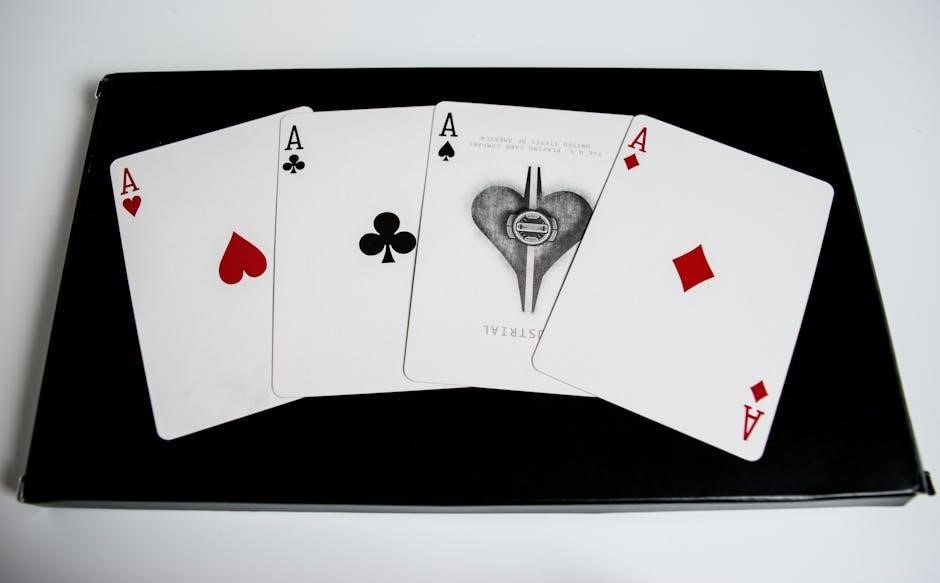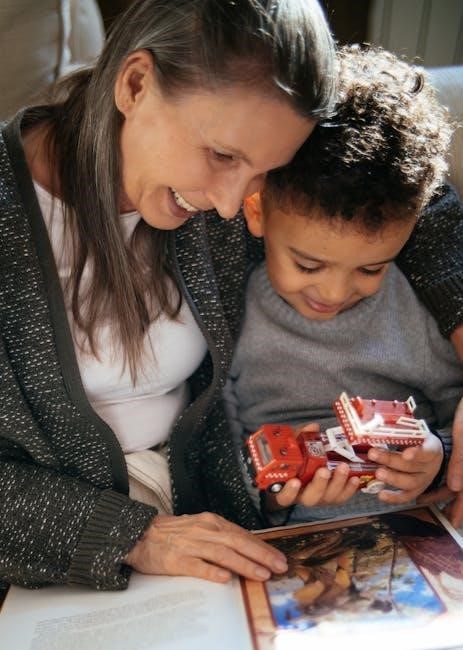Amy Tan’s 1989 novel explores the intricate bonds between Chinese immigrant mothers and their American-born daughters, weaving 16 interconnected stories symbolizing a mahjong game.
Set in San Francisco, it delves into cultural clashes, personal struggles, and the enduring power of love, resonating universally with its poignant portrayal of family dynamics.
Overview of the Novel
The Joy Luck Club is a poignant exploration of the lives of four Chinese immigrant mothers and their American-born daughters in San Francisco. Structured like a mahjong game, the novel is divided into four parts, each containing four interconnected stories. These narratives weave together the mothers’ pasts in China and their daughters’ modern lives in America, highlighting cultural clashes, generational gaps, and the universal bonds of family. Through richly drawn characters and vivid storytelling, Amy Tan examines themes of identity, tradition, and the immigrant experience; The novel’s layered structure and emotional depth have made it a beloved classic in contemporary literature.
Historical Context and Background
The Joy Luck Club is set against the backdrop of post-1949 China and the experiences of Chinese immigrants in America. The novel reflects the cultural and social challenges faced by these immigrants, including the aftermath of the Communist Revolution and the struggles of adapting to a new country. The Joy Luck Club itself was formed by four Chinese women in San Francisco as a means of coping with their losses and finding hope in their new lives. The historical context underscores themes of displacement, resilience, and the enduring ties between generations.
The novel also touches on the broader context of Sino-American relations and the personal histories of Chinese immigrants, providing a rich tapestry of historical and cultural insights.

Author Background: Amy Tan

Amy Tan, born in 1952 to Chinese immigrants, grew up in California. She pursued English and linguistics in college, defying her mother’s expectations to become a writer.
Amy Tan’s Biography
Amy Tan was born on February 19, 1952, in Oakland, California, to Chinese immigrant parents. Her father, John Tan, was a Baptist minister, and her mother, Daisy Tan, was a homemaker.
Tragedy struck when Amy was 15; her father and older brother died of brain tumors within six months of each other. This loss deeply influenced her writing and worldview.
Tan initially studied English and linguistics in college but later earned a master’s degree in creative writing. She began her career as a freelance writer before publishing her debut novel, The Joy Luck Club, in 1989.
Her personal experiences, including a trip to China to meet her half-sisters, heavily inspired her work. Tan’s writing often explores themes of identity, family, and cultural heritage, resonating with readers worldwide.
Inspiration for “The Joy Luck Club”
Inspiration for “The Joy Luck Club”
Amy Tan drew inspiration for The Joy Luck Club from her personal experiences and a transformative trip to China with her mother. Meeting her half-sisters in China sparked a deep exploration of mother-daughter relationships and cultural identity. Tan also reflected on her own complex bond with her mother, Daisy, which influenced the novel’s themes of generational and cultural divides. The idea of a mahjong club symbolized the unity and resilience of immigrant women, blending tradition with their new American lives. These experiences shaped the book’s emotional core, making it a poignant exploration of love, loss, and heritage.

Plot and Structure of the Novel
The novel intertwines 16 stories, symbolizing a mahjong game, exploring the lives of four Chinese immigrant families through alternating narratives of mothers and daughters.
Interwoven Stories and Mahjong Symbolism
The novel is structured like a mahjong game, with four parts and sixteen chapters, each symbolizing a seat at the table. The stories of mothers and daughters intertwine, reflecting the game’s rules and strategies. Through this structure, Tan mirrors the complexities of human relationships, where each “hand” represents a life shaped by chance and choice. The mahjong games serve as a backdrop, symbolizing the balance between luck and skill, much like the characters’ experiences. This unique framework highlights the cultural and emotional connections between generations, weaving past and present into a seamless narrative that explores identity, tradition, and resilience.
Narrative Style: Mothers and Daughters
Amy Tan’s narrative alternates between the voices of four Chinese immigrant mothers and their four American-born daughters, creating a rich, layered exploration of generational and cultural divides. The mothers recount their hardships in China, while their daughters navigate modern American life, revealing the tension between tradition and assimilation. Tan’s use of dual perspectives allows readers to witness the same events through differing lenses, emphasizing misunderstandings and unspoken emotions. This narrative style underscores the universal challenges of mother-daughter relationships, blending humor, tragedy, and resilience. By giving each character a distinct voice, Tan crafts a deeply human story that transcends cultural boundaries, resonating with readers worldwide.

Themes in “The Joy Luck Club”
The novel explores mother-daughter relationships, cultural identity, and generational conflicts, highlighting the struggles of immigration, loss, and the pursuit of hope across two worlds.
Mother-Daughter Relationships
The novel delves into the complex, often fraught relationships between Chinese immigrant mothers and their American-born daughters. These bonds are marked by love, misunderstanding, and cultural divides.
The mothers, shaped by their traumatic pasts in China, struggle to communicate their hopes and sacrifices to their daughters, who navigate American identities and rebel against tradition.
Through interwoven narratives, Tan reveals the emotional depth of these relationships, highlighting the generational gap and the daughters’ eventual understanding of their mothers’ resilience and devotion.
Ultimately, the novel portrays the universal struggle of bridging generational and cultural divides, emphasizing the enduring power of maternal love despite misunderstandings and conflicts.
Cultural Conflicts and Identity
Cultural tensions are central to the novel, as Chinese immigrant mothers and their American-born daughters navigate differing values and traditions.
The mothers cling to their heritage, while their daughters embrace American culture, leading to clashes over identity and belonging.
Tan vividly portrays the daughters’ struggles to reconcile their dual identities, caught between ancestral expectations and modern aspirations.
These conflicts highlight the broader immigrant experience, where cultural preservation and adaptation collide, shaping the characters’ sense of self and community.
The novel underscores the challenges of maintaining cultural roots while assimilating into a new society, resonating with readers facing similar identity dilemmas.
Loss, Memory, and Hope
Loss is a unifying theme in The Joy Luck Club, as the characters grapple with personal and collective tragedies.
The mothers’ memories of their past in China, marked by hardship and sacrifice, shape their identities and relationships with their daughters.
Memory serves as both a burden and a bridge, connecting generations while highlighting the emotional chasm between them.
Hope emerges as a resilience born from adversity, as the women strive to create better lives for themselves and their families.
The Joy Luck Club itself symbolizes this duality, offering a space for shared stories and the promise of renewal amidst loss.
Through these interwoven narratives, Tan illustrates how hope and memory intertwine to sustain the characters through life’s challenges.

Key Characters
The novel centers around four Chinese immigrant mothers—Suyuan, Lindo, Ying-ying, and An-mei—and their American-born daughters, Jing-mei, Waverly, Lena, and Rose, exploring their complex relationships and cultural dynamics.
The Mothers: Suyuan, Lindo, Ying-ying, and An-mei
The four mothers—Suyuan, Lindo, Ying-ying, and An-mei—are central to the novel, each bringing unique experiences shaped by their lives in China. Suyuan, the founder of the Joy Luck Club, embodies resilience and hope after losing her first family during the war. Lindo, known for her cunning and strength, escaped an arranged marriage to build a new life. Ying-ying’s past is marked by tragedy and silence, influencing her strained relationship with her daughter. An-mei’s story revolves around her mother’s sacrifices and a symbolic scar, reflecting themes of love and redemption. Together, they navigate cultural and generational gaps, striving to connect with their American-born daughters while holding onto their heritage.
The Daughters: Jing-mei, Waverly, Lena, and Rose
Jing-mei, Waverly, Lena, and Rose are the American-born daughters of the Joy Luck Club mothers. Jing-mei struggles with her identity and her mother’s expectations, while Waverly, a chess prodigy, grapples with the weight of her mother’s pride and her own insecurities. Lena faces a troubled marriage and financial pressures, reflecting the tension between tradition and modernity. Rose, the quiet and often overlooked daughter, seeks self-worth and a voice in her family. Their stories reveal the challenges of bridging cultural gaps and understanding their mothers’ pasts, highlighting the universal struggle of finding one’s place between heritage and personal aspiration.

Symbolism in the Novel
The Joy Luck Club and mahjong symbolize hope, resilience, and the intricate game of life, reflecting the mothers’ struggles and daughters’ journeys between tradition and modernity.
The Significance of Mahjong
Mahjong serves as a powerful symbol in The Joy Luck Club, representing community, strategy, and the complexities of life. The game, played by the mothers, reflects their resilience and hope, as it binds them together in shared experiences. Each tile and move symbolizes the intricate balance between chance and skill, mirroring the characters’ struggles with fate and control. The game also represents cultural preservation, as it connects the mothers to their Chinese heritage while adapting to their new American lives. Through mahjong, Amy Tan highlights the blending of tradition and modernity, as well as the enduring bonds formed through shared challenges and memories.
The Joy Luck Club as a Symbol
The Joy Luck Club itself is a profound symbol of hope and unity. Founded by Suyuan Woo, the club embodies the immigrant experience, offering solace and camaraderie among its members. The club’s name reflects the duality of life—joy and luck intertwined with hardship and loss. It serves as a sanctuary where the mothers can momentarily escape their struggles, finding strength in shared stories and mahjong games. The club also symbolizes the enduring spirit of its members, who, despite their past traumas, continue to seek happiness and prosperity in their new lives. This duality mirrors the broader themes of resilience and adaptation in the novel.

Legacy and Impact
Amy Tan’s “The Joy Luck Club” is a modern classic, celebrated for its profound portrayal of cultural identity and mother-daughter relationships, leaving a lasting impact on Asian-American literature.
Success and Reception
“The Joy Luck Club” was a New York Times bestseller for over 40 weeks, praised for its emotional depth and cultural insight. The novel resonated widely, becoming a landmark in Asian-American literature. Its exploration of mother-daughter relationships and cultural identity earned critical acclaim. The book’s success led to a film adaptation and further solidified its place in contemporary literature. Readers and critics alike celebrated its nuanced storytelling, making it a timeless classic that continues to inspire new generations of writers and readers.
Cultural Significance
“The Joy Luck Club” holds profound cultural significance as it bridges the gap between Chinese and American cultures, offering a deeply personal yet universally relatable narrative. The novel has been instrumental in challenging stereotypes and fostering understanding of Asian-American experiences. Its exploration of identity, tradition, and cultural clashes resonated widely, making it a pivotal work in contemporary literature. The book’s success paved the way for greater representation of Asian voices in media and literature, inspiring countless authors and adaptations. Its enduring popularity underscores its ability to connect readers across cultures, making it a timeless exploration of heritage and belonging.

Film Adaptation
The novel was adapted into a 1993 film featuring an all-Asian cast, directed by Wayne Wang, with Amy Tan and Ronald Bass as co-screenwriters and producers.
Production and Screenplay
The film adaptation of The Joy Luck Club was a collaborative effort between Amy Tan, Ronald Bass, and director Wayne Wang. Tan and Bass co-wrote the screenplay, ensuring the emotional depth and cultural nuances of the novel were preserved. The production team, including producers Patrick Markey and Oliver Stone, worked closely with the cast to bring authenticity to the story. Filming primarily took place in San Francisco and China, capturing the vibrant settings that mirror the characters’ journeys. The screenplay stayed true to the novel’s structure, weaving the mothers’ and daughters’ stories seamlessly, earning acclaim for its faithful adaptation.
Reception of the Film
The film adaptation of The Joy Luck Club received widespread critical acclaim for its authentic portrayal of Asian-American experiences. Released in 1993, it was one of the first major Hollywood films to feature an all-Asian cast, marking a significant milestone in representation. Audiences and critics praised its emotional depth, faithful adaptation of the novel, and strong performances. The film was celebrated for its ability to resonate with diverse audiences while staying true to the cultural nuances of Amy Tan’s story. Its success helped pave the way for more diverse storytelling in Hollywood, leaving a lasting impact on Asian-American cinema and culture.

Cultural and Literary Impact
The Joy Luck Club revolutionized Asian-American literature, breaking stereotypes and inspiring a wave of diverse storytelling. Its success paved the way for broader representation in media and literature.
Representation in Media
The Joy Luck Club played a pivotal role in advancing Asian-American representation in media. The 1993 film adaptation, featuring an all-Asian cast, marked a milestone in Hollywood diversity. Amy Tan’s collaboration on the screenplay ensured authentic storytelling, resonating deeply with audiences. The novel and film collectively inspired a new wave of Asian-American narratives, challenging stereotypes and fostering empathy. By depicting the complexities of cultural identity, The Joy Luck Club paved the way for more inclusive media, influencing both literature and cinema. Its impact continues to be felt, encouraging diverse voices and stories in mainstream culture.
Influence on Asian-American Literature
The Joy Luck Club revolutionized Asian-American literature by offering a deeply personal yet universally relatable narrative. Amy Tan’s work broke cultural barriers, inspiring a generation of writers to explore their heritage. The novel’s success proved there was a wide audience for stories about the Asian-American experience. It challenged stereotypes and provided a platform for marginalized voices. Many authors have cited Tan as an inspiration, crediting her with paving the way for diverse storytelling. Her influence continues to shape contemporary literature, emphasizing the importance of identity, family, and cultural legacy. The novel remains a cornerstone of Asian-American literary history.
Amy Tan’s The Joy Luck Club stands as a modern classic, offering timeless insights into family, culture, and identity.
Its enduring relevance continues to inspire readers.
Enduring Relevance of the Novel
The Joy Luck Club remains a powerful exploration of cultural identity and familial bonds, resonating across generations.
Its themes of love, loss, and resilience continue to captivate readers, making it a timeless classic in contemporary literature.
Final Thoughts on “The Joy Luck Club”
Amy Tan’s masterpiece remains a profound exploration of identity, culture, and family, continuing to resonate deeply with readers worldwide.
Its universal themes of love, loss, and resilience ensure its lasting impact on literature and culture.
The novel’s ability to bridge generational and cultural divides makes it a timeless classic, inspiring both personal reflection and broader conversations about heritage and belonging.